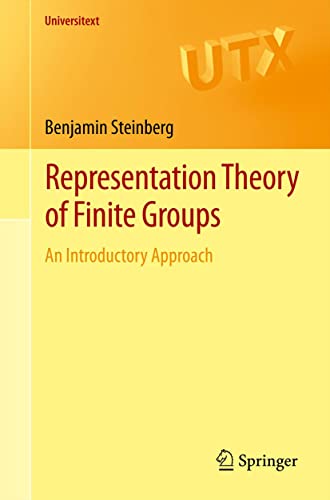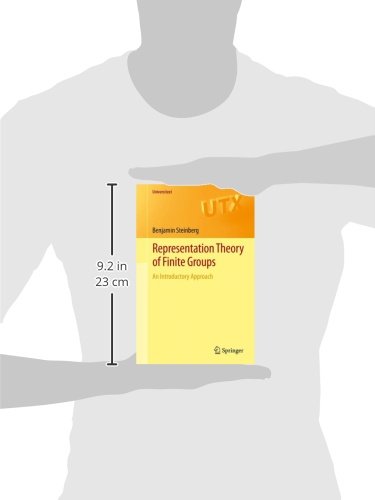



Representation Theory of Finite Groups: An Introductory Approach (Universitext)
M**W
Nice Undergraduate Text
I did a reading project on representation theory in my final year as an undergraduate math student. I found some of the resources often recommended difficult to understand and I eventually came across this text. The book is easy to understand and well written with some nice applications. It's a very nice resource for a first look at representation theory, although it skips important concepts such as modules and tensors. I found that the text by Curtis and Reiner was a nice follow up to Steinberg's text for those interested in pursuing the topic further.
J**R
High-brow with little explanation
This book is okay ... if you already understand representation theory. It is incomprehensible to someone new to the field. The author is extremely complicated and difficult to understand. Doesn't explain the in-between steps or how they arrived at such conclusions. Picks representative matrices, seemingly out of a hat, without showing how they made such a decision. The author is either too deep in the weeds to see it or is trying to sound more important/intelligent than they actually are. You will need another book to read in tandem with this; otherwise, you will be completely lost.
A**S
Great Undegraduate Textbook
Representation theory of finite groups has historically been a subject withheld from the mathematically non-elite, a subject that one can only learn once you've completed a laundry list of prerequisites. This is an absolute shame. It is a shame that a subject so beautiful, intuitive, and with such satisfying results so close to the surface, is not accessible to a wider audience. In particular, I think it would go a long way to helping undergraduate math students see the beauty in mathematics if they were able to get a taste of representation theory. Moreover, teaching representation theory to undergraduates helps them understand an important concept in mathematics that is not said often enough: one should study a class of objects, by their actions on other objects. Sadly, as I have said, historically this subject has had an alienating list of prerequisites (comfort with module theory, ring theory, and more specifically group rings).A big part of the reason for this alienation is the supply of textbooks on the representation theory of finite groups. Classically there are only two "real" textbooks: Serre's 'Linear Representations of Finite Groups' and the glib beginning of Fulton and Harris's 'Representation Theory: A First Course'. Both of these are just too advanced for and undergraduate to comfortably digest.Luckily, all is not lost thanks to Dr. Steinberg. This book is precisely the missing key to being able to successfully hold an undergraduate course in representation theory. Dr. Steinberg has struck the perfect balance between requiring little prior knowledge (really, one just needs to understand basic group theory and linear algebra, the notion of the tensor product isn't even needed) and covering all the important results. Dr. Steinberg achieves this by a hands-on, no-index-spared approach. In other words, the true character (no pun intended) of the constructions aren't hidden behind some compactified notation, they are fully written out for the world to see. Not only does this lessen the prerequisite knowledge, but it is also (in my opinion) the correct approach for a first time introduction to representation theory. Dr. Steingberg's text doesn't shy away from computations (something a lot of representation theory books tend to do--they often give a character table and say "which is easily derivable"), it encourages them via a plethora of examples and general techniques for such computations.Ok, besides the methodological reasons Dr. Steinberg's book is great, here are some particular aspects of the book that make it a valuable resource:-An explicit statement of Mackey's Irreducibility Criterion, which is proved in a user friendly way. It's hard to find this statement proved in an understandable way. It's in Isaac's character theory book, but it's hard to follow.-A palatable introduction to the representation theory of the symmetric group. It's no Sagan, but it's not supposed to be. It still introduces all the necessary concepts (e.g. polytabloids, Ferrer's diagrams, etc.) and shows the beautiful interplay between combinatorics and representation theory.-A proof of the most fundamental application of rep theory to finite group theory: Burnside's Theorem. Dr. Steinberg takes the time (there's an entire chapter devoted to it) to build up to the proof, leaving no detail or lemma for the reader to fill in (and for such an important result, this is a good thing).-An introduction to the Fourier analysis of finite groups including an application to graph theory, in the form of the Cayley graph.-An introduction to random walks on groups.All in all, while I can't say that Dr. Steinberg's book is perfect, I think that it is the first viable choice as a textbook for the undergraduate rep theory course, that I think is so sorely needed.
J**S
Excellent introduction
This book is a minor masterpiece. It takes a difficult subject and explains it clearly without dumbing it down. Starting from a basic knowledge of linear algebra, this books covers almost all the basics of rep theory for finite groups. The style is very clear and everything is explained well.The exercises seem pitched at the right level, not trivial but not impossible for the beginner.A perfect book for self study.
ぐ**ん
わかりやすい
有限群の表現は、表現論の最も基本的な概念の一つであり、特にJ.P.Serre著「有限群の線形表現」が有名であろう. だが、それと同時に表現論を学ぶための最初の関門にもなっているようである. だが、この本は「入門」と銘打ってあるように、線形代数と群論の基本的な概念をある程度理解していれば読めるようにしてあり、各定理の証明が非常に丁寧に書かれている. また、練習問題も易しいものが多く、このテキストの薄さを補うような内容になっている.(特にSection4のExerciseに登場する表現のテンソル積はやった方がよいと思う.)では内容はどうなのかというと、線形代数の復習から始め、有限群の表現の定義、既約表現への直和分解、指標の理論などを学んで1.バーンサイドの定理:位数が2つの素数のべき乗である群は必ず可解群になる.(Section6)2. 位数が奇数の群は自明でない実指標を持たず、この群の位数から共役類の個数を引いたものは必ず16で割り切れる.(Section9)3.対称群の表現の初歩的な説明. (Section10)(Bruce.E.Sagan著「Symmetric Group」を後に読むとよい. ちょうど続編のような位置づけになっている.)4.離散確率への応用. (Section5−4、11)など、読者にさまざまな応用を紹介してくれている. 人にも依るが、有限群の表現論を学ぶなら私はまずこの本をおススメする. (もしくはG.James著「Representations and Characters of Groups 2nd.ed」も分かりやすく、この本よりも詳しい. ただし若干書き方に癖があり、少々くどいと思う人もいるかも.)